Food Safety and Agricultural Practices
VerifiedAdded on 2020/06/04
|10
|3083
|51
AI Summary
This assignment delves into the multifaceted topic of food safety. It examines the role of heavy metals in agricultural soils and their implications for food safety within the European Union. The analysis also considers various aspects of food safety management systems, including implementation challenges and benefits, particularly within the Turkish dairy industry. Furthermore, the document explores innovative approaches like high hydrostatic pressure and biopreservation in ensuring food safety, particularly for dry-cured ham. It highlights the importance of addressing norovirus contamination in food and the impact of heavy metals on soybean quality and accumulation. Finally, the assignment discusses advancements in genetically engineered (GE) food safety assessment using 'omics' techniques and long-term animal feeding studies.
Contribute Materials
Your contribution can guide someone’s learning journey. Share your
documents today.
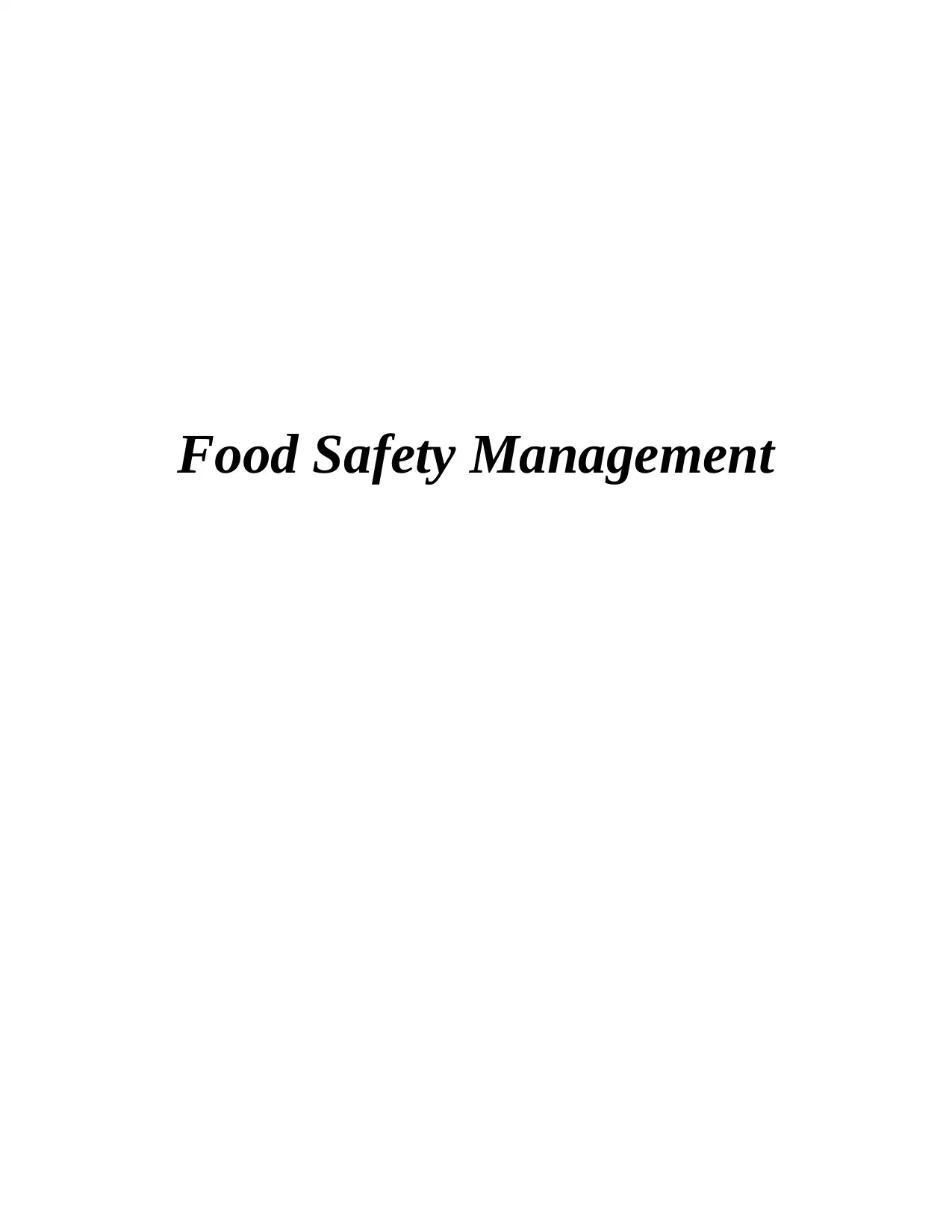
Food Safety Management
Secure Best Marks with AI Grader
Need help grading? Try our AI Grader for instant feedback on your assignments.
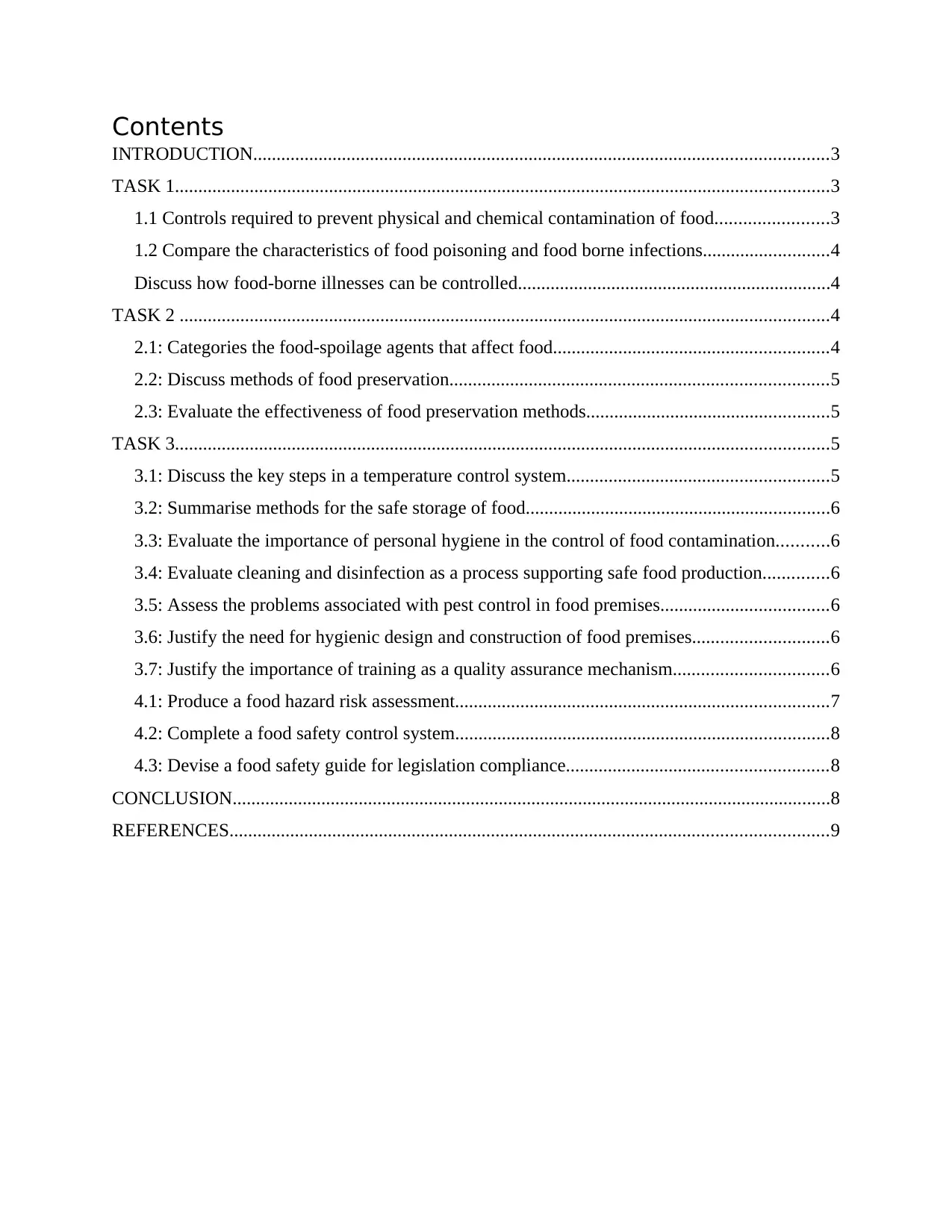
Contents
INTRODUCTION...........................................................................................................................3
TASK 1............................................................................................................................................3
1.1 Controls required to prevent physical and chemical contamination of food........................3
1.2 Compare the characteristics of food poisoning and food borne infections...........................4
Discuss how food-borne illnesses can be controlled...................................................................4
TASK 2 ...........................................................................................................................................4
2.1: Categories the food-spoilage agents that affect food...........................................................4
2.2: Discuss methods of food preservation.................................................................................5
2.3: Evaluate the effectiveness of food preservation methods....................................................5
TASK 3............................................................................................................................................5
3.1: Discuss the key steps in a temperature control system........................................................5
3.2: Summarise methods for the safe storage of food.................................................................6
3.3: Evaluate the importance of personal hygiene in the control of food contamination...........6
3.4: Evaluate cleaning and disinfection as a process supporting safe food production..............6
3.5: Assess the problems associated with pest control in food premises....................................6
3.6: Justify the need for hygienic design and construction of food premises.............................6
3.7: Justify the importance of training as a quality assurance mechanism.................................6
4.1: Produce a food hazard risk assessment................................................................................7
4.2: Complete a food safety control system................................................................................8
4.3: Devise a food safety guide for legislation compliance........................................................8
CONCLUSION................................................................................................................................8
REFERENCES................................................................................................................................9
INTRODUCTION...........................................................................................................................3
TASK 1............................................................................................................................................3
1.1 Controls required to prevent physical and chemical contamination of food........................3
1.2 Compare the characteristics of food poisoning and food borne infections...........................4
Discuss how food-borne illnesses can be controlled...................................................................4
TASK 2 ...........................................................................................................................................4
2.1: Categories the food-spoilage agents that affect food...........................................................4
2.2: Discuss methods of food preservation.................................................................................5
2.3: Evaluate the effectiveness of food preservation methods....................................................5
TASK 3............................................................................................................................................5
3.1: Discuss the key steps in a temperature control system........................................................5
3.2: Summarise methods for the safe storage of food.................................................................6
3.3: Evaluate the importance of personal hygiene in the control of food contamination...........6
3.4: Evaluate cleaning and disinfection as a process supporting safe food production..............6
3.5: Assess the problems associated with pest control in food premises....................................6
3.6: Justify the need for hygienic design and construction of food premises.............................6
3.7: Justify the importance of training as a quality assurance mechanism.................................6
4.1: Produce a food hazard risk assessment................................................................................7
4.2: Complete a food safety control system................................................................................8
4.3: Devise a food safety guide for legislation compliance........................................................8
CONCLUSION................................................................................................................................8
REFERENCES................................................................................................................................9
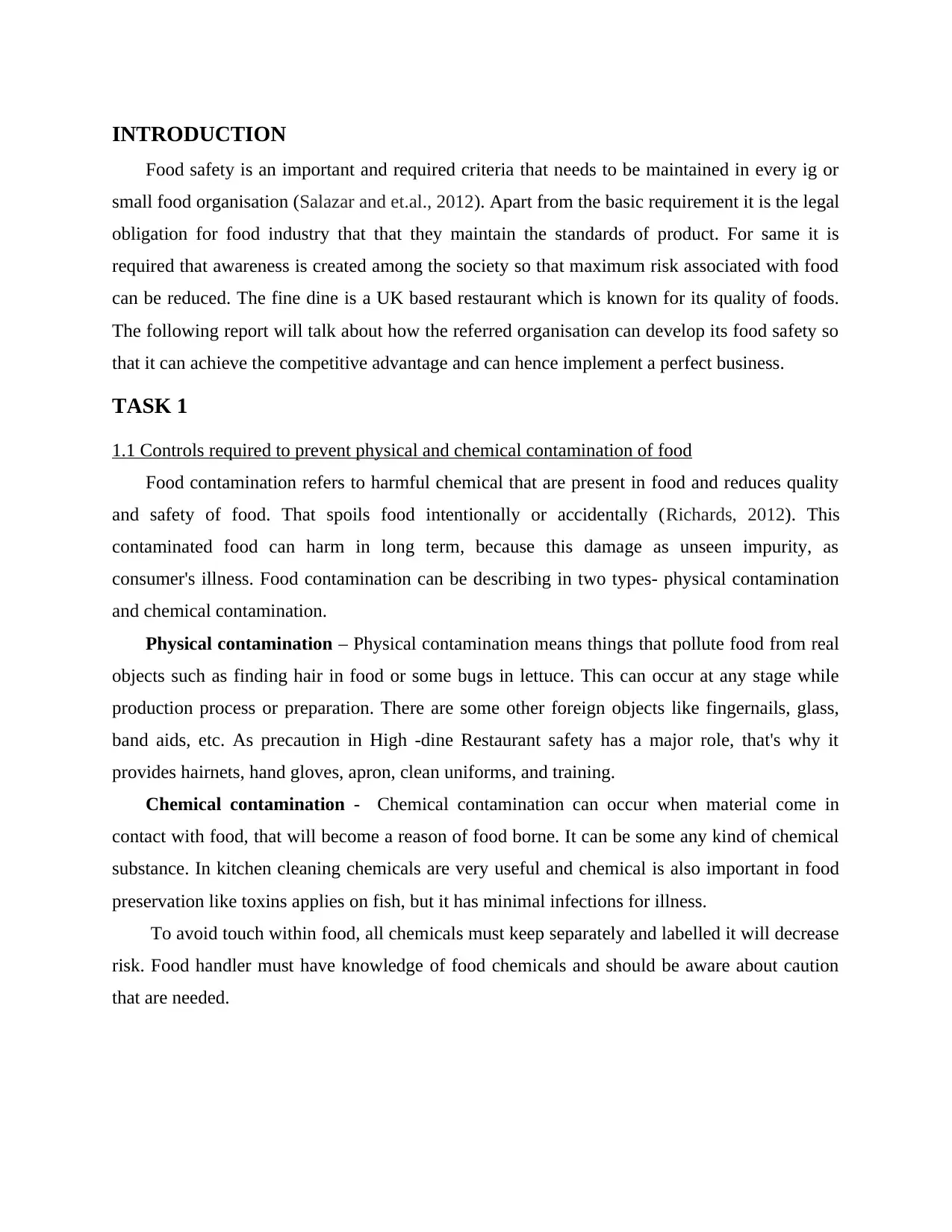
INTRODUCTION
Food safety is an important and required criteria that needs to be maintained in every ig or
small food organisation (Salazar and et.al., 2012). Apart from the basic requirement it is the legal
obligation for food industry that that they maintain the standards of product. For same it is
required that awareness is created among the society so that maximum risk associated with food
can be reduced. The fine dine is a UK based restaurant which is known for its quality of foods.
The following report will talk about how the referred organisation can develop its food safety so
that it can achieve the competitive advantage and can hence implement a perfect business.
TASK 1
1.1 Controls required to prevent physical and chemical contamination of food
Food contamination refers to harmful chemical that are present in food and reduces quality
and safety of food. That spoils food intentionally or accidentally (Richards, 2012). This
contaminated food can harm in long term, because this damage as unseen impurity, as
consumer's illness. Food contamination can be describing in two types- physical contamination
and chemical contamination.
Physical contamination – Physical contamination means things that pollute food from real
objects such as finding hair in food or some bugs in lettuce. This can occur at any stage while
production process or preparation. There are some other foreign objects like fingernails, glass,
band aids, etc. As precaution in High -dine Restaurant safety has a major role, that's why it
provides hairnets, hand gloves, apron, clean uniforms, and training.
Chemical contamination - Chemical contamination can occur when material come in
contact with food, that will become a reason of food borne. It can be some any kind of chemical
substance. In kitchen cleaning chemicals are very useful and chemical is also important in food
preservation like toxins applies on fish, but it has minimal infections for illness.
To avoid touch within food, all chemicals must keep separately and labelled it will decrease
risk. Food handler must have knowledge of food chemicals and should be aware about caution
that are needed.
Food safety is an important and required criteria that needs to be maintained in every ig or
small food organisation (Salazar and et.al., 2012). Apart from the basic requirement it is the legal
obligation for food industry that that they maintain the standards of product. For same it is
required that awareness is created among the society so that maximum risk associated with food
can be reduced. The fine dine is a UK based restaurant which is known for its quality of foods.
The following report will talk about how the referred organisation can develop its food safety so
that it can achieve the competitive advantage and can hence implement a perfect business.
TASK 1
1.1 Controls required to prevent physical and chemical contamination of food
Food contamination refers to harmful chemical that are present in food and reduces quality
and safety of food. That spoils food intentionally or accidentally (Richards, 2012). This
contaminated food can harm in long term, because this damage as unseen impurity, as
consumer's illness. Food contamination can be describing in two types- physical contamination
and chemical contamination.
Physical contamination – Physical contamination means things that pollute food from real
objects such as finding hair in food or some bugs in lettuce. This can occur at any stage while
production process or preparation. There are some other foreign objects like fingernails, glass,
band aids, etc. As precaution in High -dine Restaurant safety has a major role, that's why it
provides hairnets, hand gloves, apron, clean uniforms, and training.
Chemical contamination - Chemical contamination can occur when material come in
contact with food, that will become a reason of food borne. It can be some any kind of chemical
substance. In kitchen cleaning chemicals are very useful and chemical is also important in food
preservation like toxins applies on fish, but it has minimal infections for illness.
To avoid touch within food, all chemicals must keep separately and labelled it will decrease
risk. Food handler must have knowledge of food chemicals and should be aware about caution
that are needed.
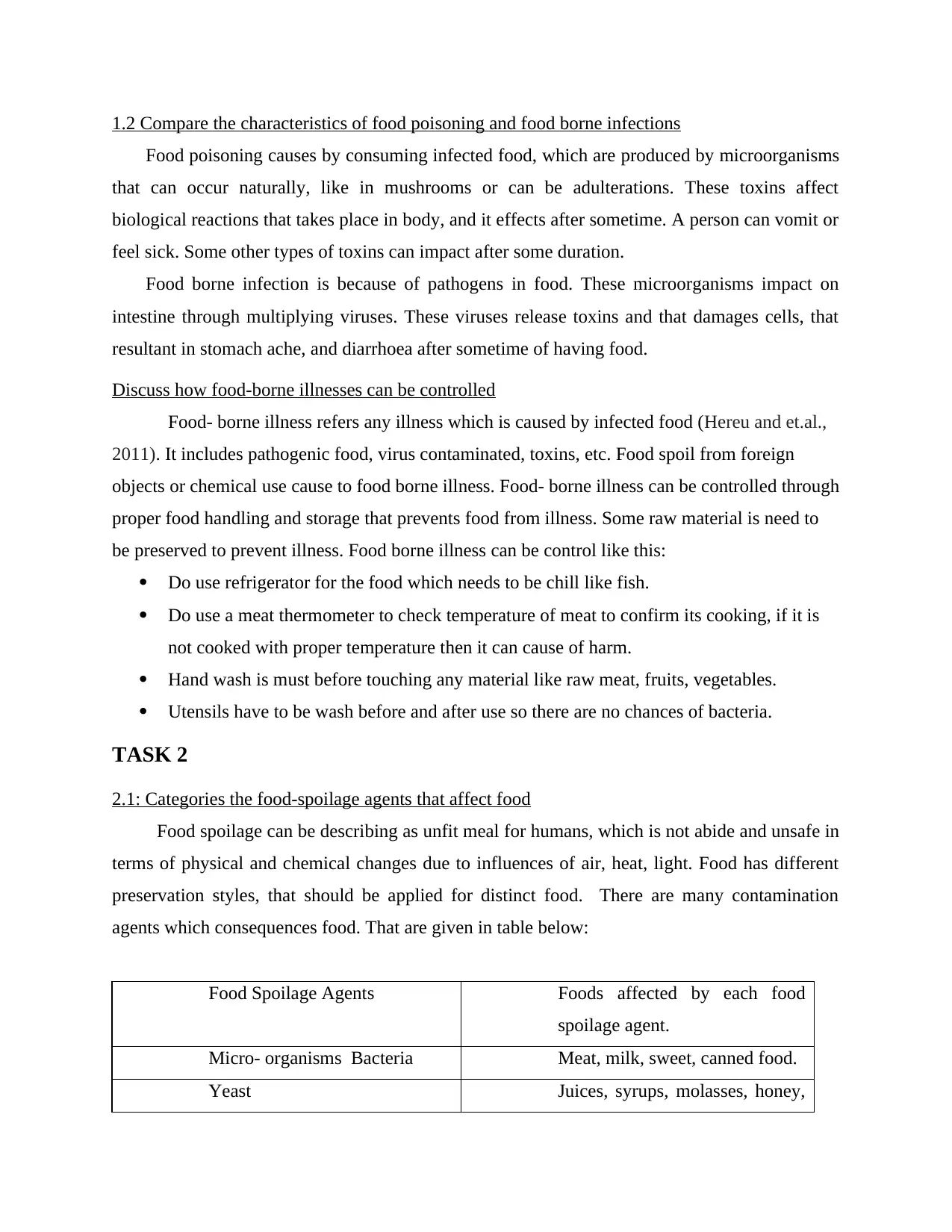
1.2 Compare the characteristics of food poisoning and food borne infections
Food poisoning causes by consuming infected food, which are produced by microorganisms
that can occur naturally, like in mushrooms or can be adulterations. These toxins affect
biological reactions that takes place in body, and it effects after sometime. A person can vomit or
feel sick. Some other types of toxins can impact after some duration.
Food borne infection is because of pathogens in food. These microorganisms impact on
intestine through multiplying viruses. These viruses release toxins and that damages cells, that
resultant in stomach ache, and diarrhoea after sometime of having food.
Discuss how food-borne illnesses can be controlled
Food- borne illness refers any illness which is caused by infected food (Hereu and et.al.,
2011). It includes pathogenic food, virus contaminated, toxins, etc. Food spoil from foreign
objects or chemical use cause to food borne illness. Food- borne illness can be controlled through
proper food handling and storage that prevents food from illness. Some raw material is need to
be preserved to prevent illness. Food borne illness can be control like this:
Do use refrigerator for the food which needs to be chill like fish.
Do use a meat thermometer to check temperature of meat to confirm its cooking, if it is
not cooked with proper temperature then it can cause of harm.
Hand wash is must before touching any material like raw meat, fruits, vegetables.
Utensils have to be wash before and after use so there are no chances of bacteria.
TASK 2
2.1: Categories the food-spoilage agents that affect food
Food spoilage can be describing as unfit meal for humans, which is not abide and unsafe in
terms of physical and chemical changes due to influences of air, heat, light. Food has different
preservation styles, that should be applied for distinct food. There are many contamination
agents which consequences food. That are given in table below:
Food Spoilage Agents Foods affected by each food
spoilage agent.
Micro- organisms Bacteria Meat, milk, sweet, canned food.
Yeast Juices, syrups, molasses, honey,
Food poisoning causes by consuming infected food, which are produced by microorganisms
that can occur naturally, like in mushrooms or can be adulterations. These toxins affect
biological reactions that takes place in body, and it effects after sometime. A person can vomit or
feel sick. Some other types of toxins can impact after some duration.
Food borne infection is because of pathogens in food. These microorganisms impact on
intestine through multiplying viruses. These viruses release toxins and that damages cells, that
resultant in stomach ache, and diarrhoea after sometime of having food.
Discuss how food-borne illnesses can be controlled
Food- borne illness refers any illness which is caused by infected food (Hereu and et.al.,
2011). It includes pathogenic food, virus contaminated, toxins, etc. Food spoil from foreign
objects or chemical use cause to food borne illness. Food- borne illness can be controlled through
proper food handling and storage that prevents food from illness. Some raw material is need to
be preserved to prevent illness. Food borne illness can be control like this:
Do use refrigerator for the food which needs to be chill like fish.
Do use a meat thermometer to check temperature of meat to confirm its cooking, if it is
not cooked with proper temperature then it can cause of harm.
Hand wash is must before touching any material like raw meat, fruits, vegetables.
Utensils have to be wash before and after use so there are no chances of bacteria.
TASK 2
2.1: Categories the food-spoilage agents that affect food
Food spoilage can be describing as unfit meal for humans, which is not abide and unsafe in
terms of physical and chemical changes due to influences of air, heat, light. Food has different
preservation styles, that should be applied for distinct food. There are many contamination
agents which consequences food. That are given in table below:
Food Spoilage Agents Foods affected by each food
spoilage agent.
Micro- organisms Bacteria Meat, milk, sweet, canned food.
Yeast Juices, syrups, molasses, honey,
Secure Best Marks with AI Grader
Need help grading? Try our AI Grader for instant feedback on your assignments.
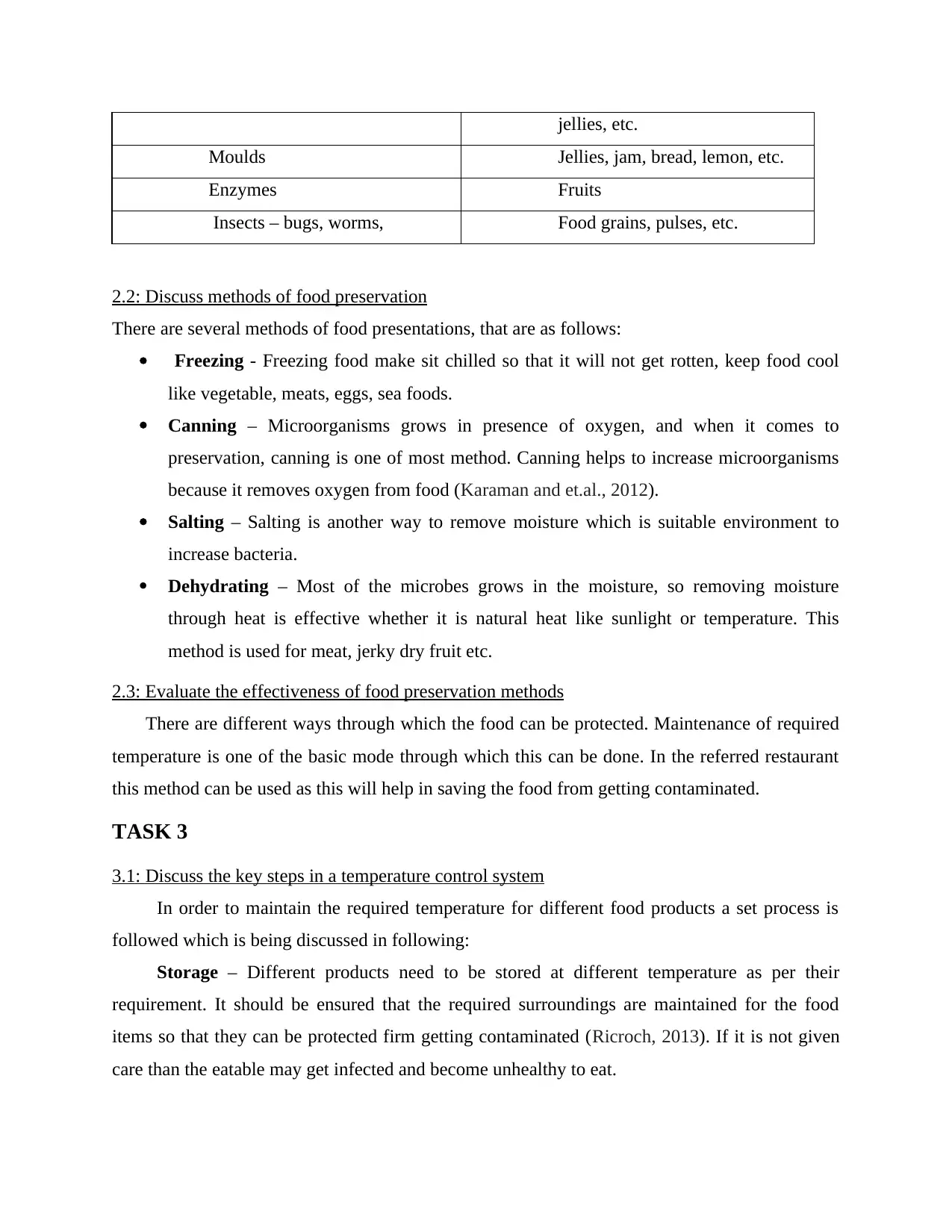
jellies, etc.
Moulds Jellies, jam, bread, lemon, etc.
Enzymes Fruits
Insects – bugs, worms, Food grains, pulses, etc.
2.2: Discuss methods of food preservation
There are several methods of food presentations, that are as follows:
Freezing - Freezing food make sit chilled so that it will not get rotten, keep food cool
like vegetable, meats, eggs, sea foods.
Canning – Microorganisms grows in presence of oxygen, and when it comes to
preservation, canning is one of most method. Canning helps to increase microorganisms
because it removes oxygen from food (Karaman and et.al., 2012).
Salting – Salting is another way to remove moisture which is suitable environment to
increase bacteria.
Dehydrating – Most of the microbes grows in the moisture, so removing moisture
through heat is effective whether it is natural heat like sunlight or temperature. This
method is used for meat, jerky dry fruit etc.
2.3: Evaluate the effectiveness of food preservation methods
There are different ways through which the food can be protected. Maintenance of required
temperature is one of the basic mode through which this can be done. In the referred restaurant
this method can be used as this will help in saving the food from getting contaminated.
TASK 3
3.1: Discuss the key steps in a temperature control system
In order to maintain the required temperature for different food products a set process is
followed which is being discussed in following:
Storage – Different products need to be stored at different temperature as per their
requirement. It should be ensured that the required surroundings are maintained for the food
items so that they can be protected firm getting contaminated (Ricroch, 2013). If it is not given
care than the eatable may get infected and become unhealthy to eat.
Moulds Jellies, jam, bread, lemon, etc.
Enzymes Fruits
Insects – bugs, worms, Food grains, pulses, etc.
2.2: Discuss methods of food preservation
There are several methods of food presentations, that are as follows:
Freezing - Freezing food make sit chilled so that it will not get rotten, keep food cool
like vegetable, meats, eggs, sea foods.
Canning – Microorganisms grows in presence of oxygen, and when it comes to
preservation, canning is one of most method. Canning helps to increase microorganisms
because it removes oxygen from food (Karaman and et.al., 2012).
Salting – Salting is another way to remove moisture which is suitable environment to
increase bacteria.
Dehydrating – Most of the microbes grows in the moisture, so removing moisture
through heat is effective whether it is natural heat like sunlight or temperature. This
method is used for meat, jerky dry fruit etc.
2.3: Evaluate the effectiveness of food preservation methods
There are different ways through which the food can be protected. Maintenance of required
temperature is one of the basic mode through which this can be done. In the referred restaurant
this method can be used as this will help in saving the food from getting contaminated.
TASK 3
3.1: Discuss the key steps in a temperature control system
In order to maintain the required temperature for different food products a set process is
followed which is being discussed in following:
Storage – Different products need to be stored at different temperature as per their
requirement. It should be ensured that the required surroundings are maintained for the food
items so that they can be protected firm getting contaminated (Ricroch, 2013). If it is not given
care than the eatable may get infected and become unhealthy to eat.
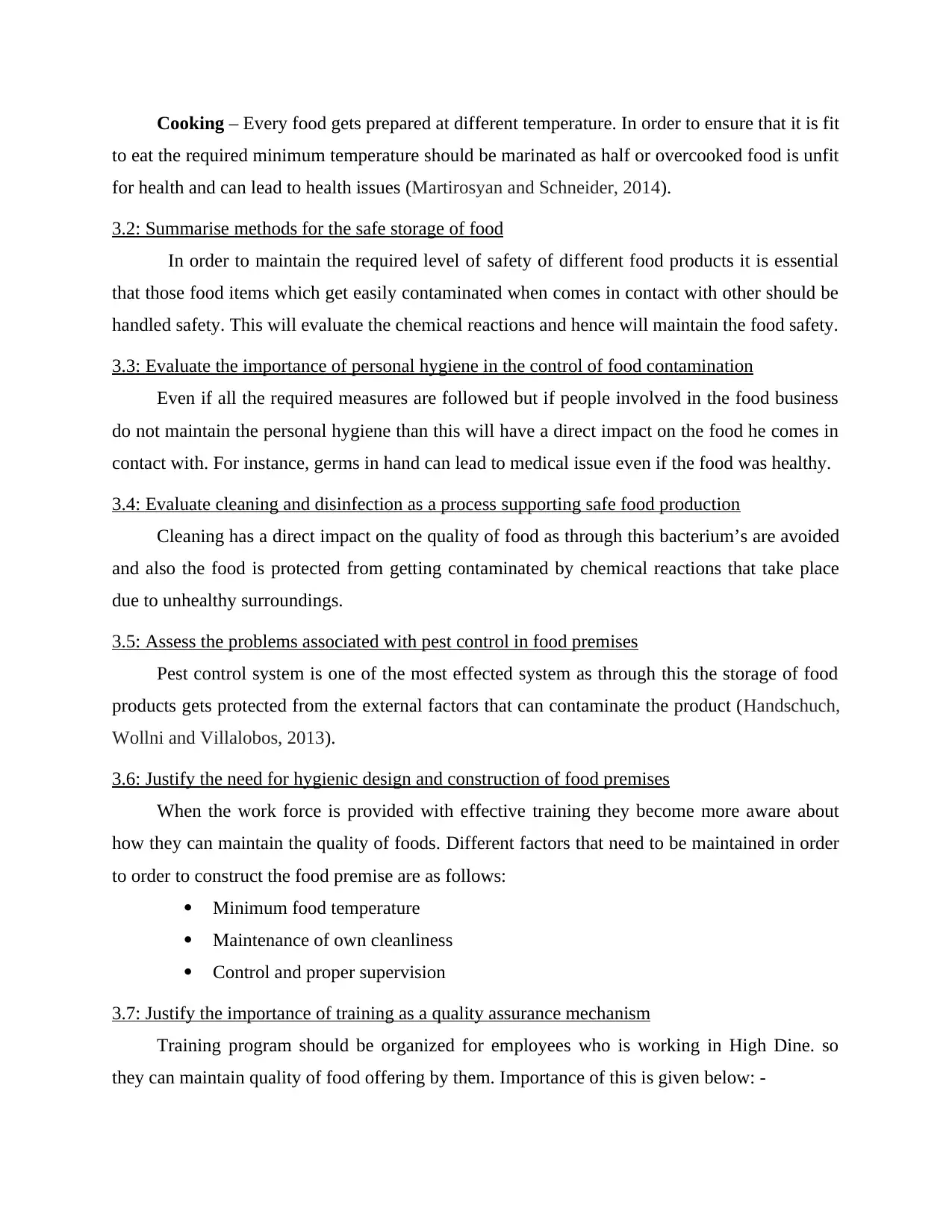
Cooking – Every food gets prepared at different temperature. In order to ensure that it is fit
to eat the required minimum temperature should be marinated as half or overcooked food is unfit
for health and can lead to health issues (Martirosyan and Schneider, 2014).
3.2: Summarise methods for the safe storage of food
In order to maintain the required level of safety of different food products it is essential
that those food items which get easily contaminated when comes in contact with other should be
handled safety. This will evaluate the chemical reactions and hence will maintain the food safety.
3.3: Evaluate the importance of personal hygiene in the control of food contamination
Even if all the required measures are followed but if people involved in the food business
do not maintain the personal hygiene than this will have a direct impact on the food he comes in
contact with. For instance, germs in hand can lead to medical issue even if the food was healthy.
3.4: Evaluate cleaning and disinfection as a process supporting safe food production
Cleaning has a direct impact on the quality of food as through this bacterium’s are avoided
and also the food is protected from getting contaminated by chemical reactions that take place
due to unhealthy surroundings.
3.5: Assess the problems associated with pest control in food premises
Pest control system is one of the most effected system as through this the storage of food
products gets protected from the external factors that can contaminate the product (Handschuch,
Wollni and Villalobos, 2013).
3.6: Justify the need for hygienic design and construction of food premises
When the work force is provided with effective training they become more aware about
how they can maintain the quality of foods. Different factors that need to be maintained in order
to order to construct the food premise are as follows:
Minimum food temperature
Maintenance of own cleanliness
Control and proper supervision
3.7: Justify the importance of training as a quality assurance mechanism
Training program should be organized for employees who is working in High Dine. so
they can maintain quality of food offering by them. Importance of this is given below: -
to eat the required minimum temperature should be marinated as half or overcooked food is unfit
for health and can lead to health issues (Martirosyan and Schneider, 2014).
3.2: Summarise methods for the safe storage of food
In order to maintain the required level of safety of different food products it is essential
that those food items which get easily contaminated when comes in contact with other should be
handled safety. This will evaluate the chemical reactions and hence will maintain the food safety.
3.3: Evaluate the importance of personal hygiene in the control of food contamination
Even if all the required measures are followed but if people involved in the food business
do not maintain the personal hygiene than this will have a direct impact on the food he comes in
contact with. For instance, germs in hand can lead to medical issue even if the food was healthy.
3.4: Evaluate cleaning and disinfection as a process supporting safe food production
Cleaning has a direct impact on the quality of food as through this bacterium’s are avoided
and also the food is protected from getting contaminated by chemical reactions that take place
due to unhealthy surroundings.
3.5: Assess the problems associated with pest control in food premises
Pest control system is one of the most effected system as through this the storage of food
products gets protected from the external factors that can contaminate the product (Handschuch,
Wollni and Villalobos, 2013).
3.6: Justify the need for hygienic design and construction of food premises
When the work force is provided with effective training they become more aware about
how they can maintain the quality of foods. Different factors that need to be maintained in order
to order to construct the food premise are as follows:
Minimum food temperature
Maintenance of own cleanliness
Control and proper supervision
3.7: Justify the importance of training as a quality assurance mechanism
Training program should be organized for employees who is working in High Dine. so
they can maintain quality of food offering by them. Importance of this is given below: -
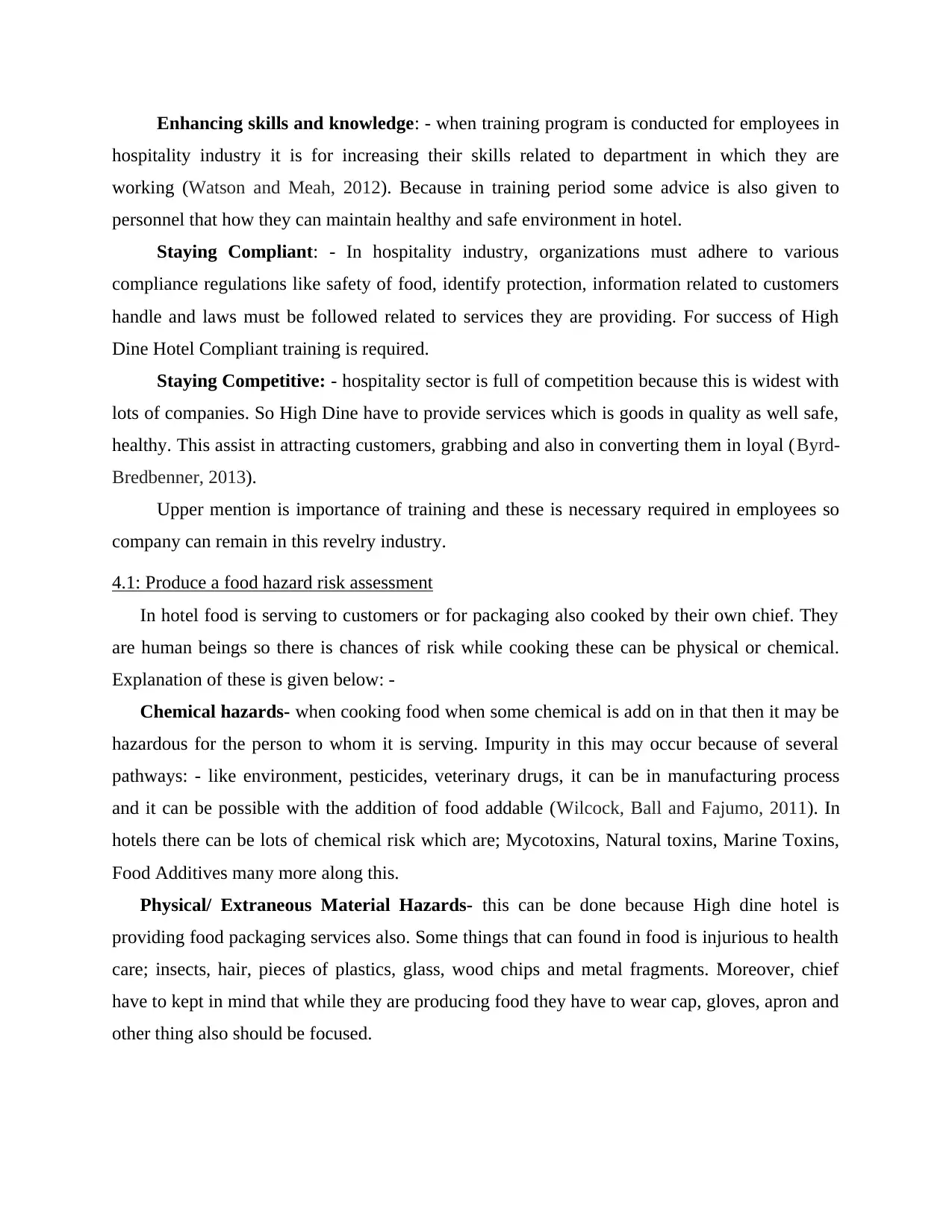
Enhancing skills and knowledge: - when training program is conducted for employees in
hospitality industry it is for increasing their skills related to department in which they are
working (Watson and Meah, 2012). Because in training period some advice is also given to
personnel that how they can maintain healthy and safe environment in hotel.
Staying Compliant: - In hospitality industry, organizations must adhere to various
compliance regulations like safety of food, identify protection, information related to customers
handle and laws must be followed related to services they are providing. For success of High
Dine Hotel Compliant training is required.
Staying Competitive: - hospitality sector is full of competition because this is widest with
lots of companies. So High Dine have to provide services which is goods in quality as well safe,
healthy. This assist in attracting customers, grabbing and also in converting them in loyal (Byrd-
Bredbenner, 2013).
Upper mention is importance of training and these is necessary required in employees so
company can remain in this revelry industry.
4.1: Produce a food hazard risk assessment
In hotel food is serving to customers or for packaging also cooked by their own chief. They
are human beings so there is chances of risk while cooking these can be physical or chemical.
Explanation of these is given below: -
Chemical hazards- when cooking food when some chemical is add on in that then it may be
hazardous for the person to whom it is serving. Impurity in this may occur because of several
pathways: - like environment, pesticides, veterinary drugs, it can be in manufacturing process
and it can be possible with the addition of food addable (Wilcock, Ball and Fajumo, 2011). In
hotels there can be lots of chemical risk which are; Mycotoxins, Natural toxins, Marine Toxins,
Food Additives many more along this.
Physical/ Extraneous Material Hazards- this can be done because High dine hotel is
providing food packaging services also. Some things that can found in food is injurious to health
care; insects, hair, pieces of plastics, glass, wood chips and metal fragments. Moreover, chief
have to kept in mind that while they are producing food they have to wear cap, gloves, apron and
other thing also should be focused.
hospitality industry it is for increasing their skills related to department in which they are
working (Watson and Meah, 2012). Because in training period some advice is also given to
personnel that how they can maintain healthy and safe environment in hotel.
Staying Compliant: - In hospitality industry, organizations must adhere to various
compliance regulations like safety of food, identify protection, information related to customers
handle and laws must be followed related to services they are providing. For success of High
Dine Hotel Compliant training is required.
Staying Competitive: - hospitality sector is full of competition because this is widest with
lots of companies. So High Dine have to provide services which is goods in quality as well safe,
healthy. This assist in attracting customers, grabbing and also in converting them in loyal (Byrd-
Bredbenner, 2013).
Upper mention is importance of training and these is necessary required in employees so
company can remain in this revelry industry.
4.1: Produce a food hazard risk assessment
In hotel food is serving to customers or for packaging also cooked by their own chief. They
are human beings so there is chances of risk while cooking these can be physical or chemical.
Explanation of these is given below: -
Chemical hazards- when cooking food when some chemical is add on in that then it may be
hazardous for the person to whom it is serving. Impurity in this may occur because of several
pathways: - like environment, pesticides, veterinary drugs, it can be in manufacturing process
and it can be possible with the addition of food addable (Wilcock, Ball and Fajumo, 2011). In
hotels there can be lots of chemical risk which are; Mycotoxins, Natural toxins, Marine Toxins,
Food Additives many more along this.
Physical/ Extraneous Material Hazards- this can be done because High dine hotel is
providing food packaging services also. Some things that can found in food is injurious to health
care; insects, hair, pieces of plastics, glass, wood chips and metal fragments. Moreover, chief
have to kept in mind that while they are producing food they have to wear cap, gloves, apron and
other thing also should be focused.
Paraphrase This Document
Need a fresh take? Get an instant paraphrase of this document with our AI Paraphraser
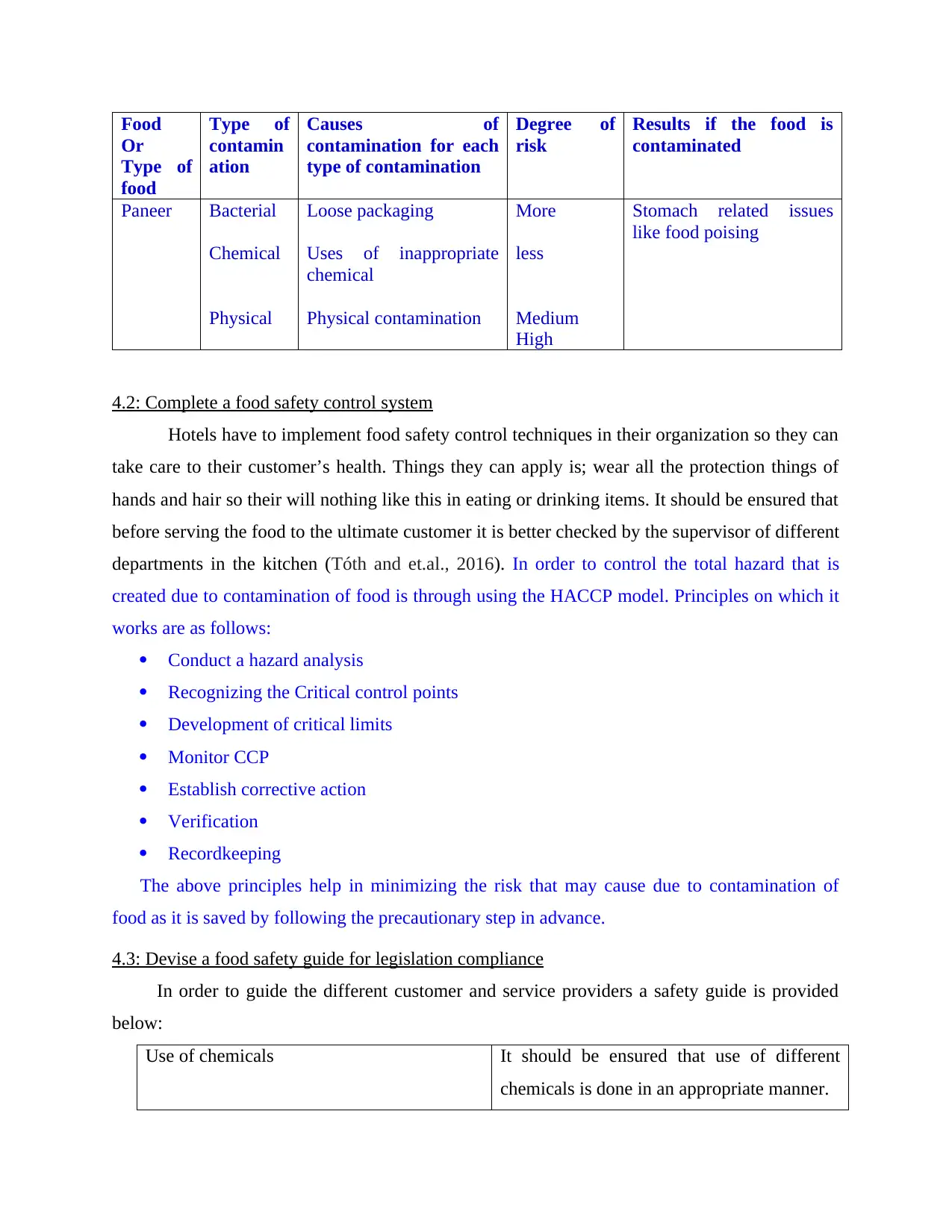
Food
Or
Type of
food
Type of
contamin
ation
Causes of
contamination for each
type of contamination
Degree of
risk
Results if the food is
contaminated
Paneer Bacterial
Chemical
Physical
Loose packaging
Uses of inappropriate
chemical
Physical contamination
More
less
Medium
High
Stomach related issues
like food poising
4.2: Complete a food safety control system
Hotels have to implement food safety control techniques in their organization so they can
take care to their customer’s health. Things they can apply is; wear all the protection things of
hands and hair so their will nothing like this in eating or drinking items. It should be ensured that
before serving the food to the ultimate customer it is better checked by the supervisor of different
departments in the kitchen (Tóth and et.al., 2016). In order to control the total hazard that is
created due to contamination of food is through using the HACCP model. Principles on which it
works are as follows:
Conduct a hazard analysis
Recognizing the Critical control points
Development of critical limits
Monitor CCP
Establish corrective action
Verification
Recordkeeping
The above principles help in minimizing the risk that may cause due to contamination of
food as it is saved by following the precautionary step in advance.
4.3: Devise a food safety guide for legislation compliance
In order to guide the different customer and service providers a safety guide is provided
below:
Use of chemicals It should be ensured that use of different
chemicals is done in an appropriate manner.
Or
Type of
food
Type of
contamin
ation
Causes of
contamination for each
type of contamination
Degree of
risk
Results if the food is
contaminated
Paneer Bacterial
Chemical
Physical
Loose packaging
Uses of inappropriate
chemical
Physical contamination
More
less
Medium
High
Stomach related issues
like food poising
4.2: Complete a food safety control system
Hotels have to implement food safety control techniques in their organization so they can
take care to their customer’s health. Things they can apply is; wear all the protection things of
hands and hair so their will nothing like this in eating or drinking items. It should be ensured that
before serving the food to the ultimate customer it is better checked by the supervisor of different
departments in the kitchen (Tóth and et.al., 2016). In order to control the total hazard that is
created due to contamination of food is through using the HACCP model. Principles on which it
works are as follows:
Conduct a hazard analysis
Recognizing the Critical control points
Development of critical limits
Monitor CCP
Establish corrective action
Verification
Recordkeeping
The above principles help in minimizing the risk that may cause due to contamination of
food as it is saved by following the precautionary step in advance.
4.3: Devise a food safety guide for legislation compliance
In order to guide the different customer and service providers a safety guide is provided
below:
Use of chemicals It should be ensured that use of different
chemicals is done in an appropriate manner.
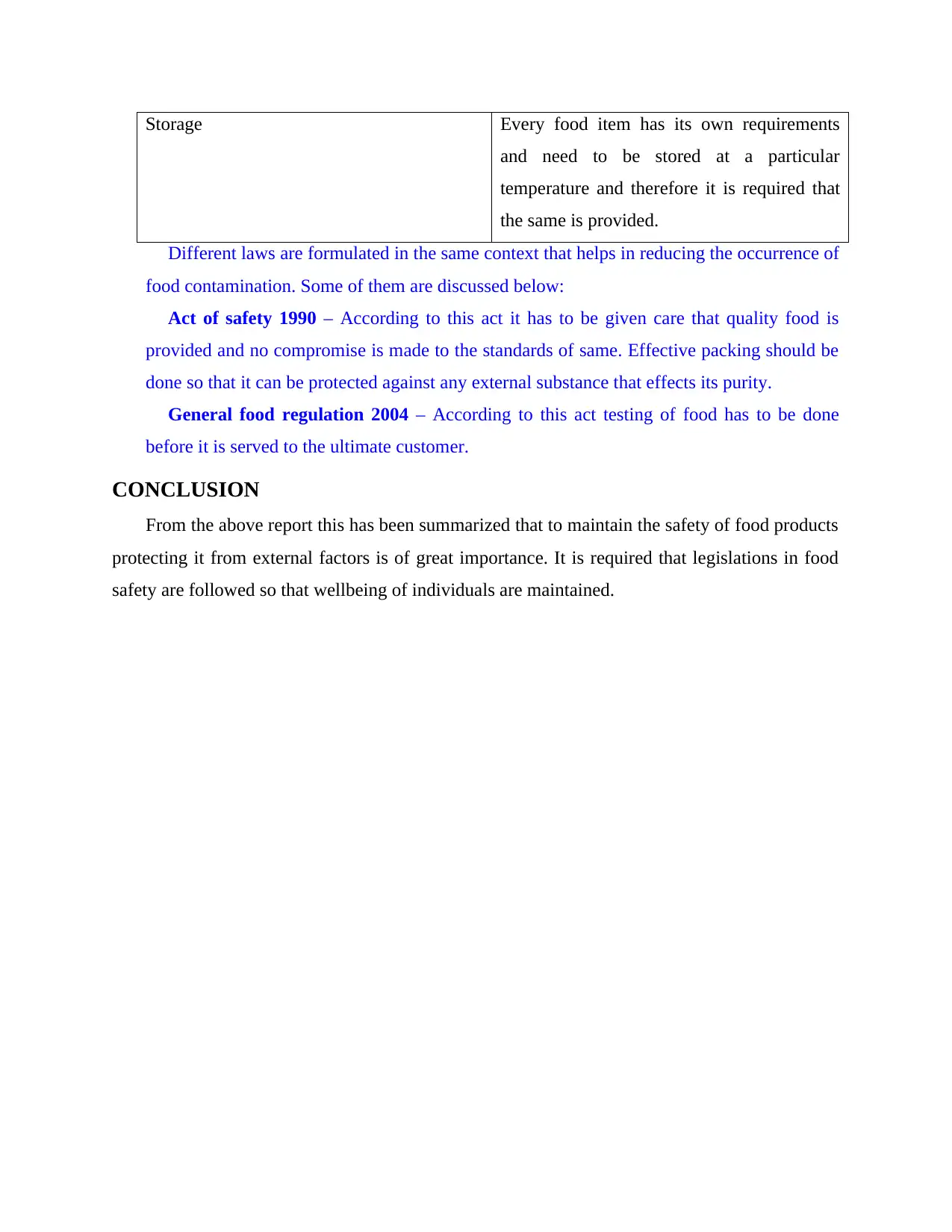
Storage Every food item has its own requirements
and need to be stored at a particular
temperature and therefore it is required that
the same is provided.
Different laws are formulated in the same context that helps in reducing the occurrence of
food contamination. Some of them are discussed below:
Act of safety 1990 – According to this act it has to be given care that quality food is
provided and no compromise is made to the standards of same. Effective packing should be
done so that it can be protected against any external substance that effects its purity.
General food regulation 2004 – According to this act testing of food has to be done
before it is served to the ultimate customer.
CONCLUSION
From the above report this has been summarized that to maintain the safety of food products
protecting it from external factors is of great importance. It is required that legislations in food
safety are followed so that wellbeing of individuals are maintained.
and need to be stored at a particular
temperature and therefore it is required that
the same is provided.
Different laws are formulated in the same context that helps in reducing the occurrence of
food contamination. Some of them are discussed below:
Act of safety 1990 – According to this act it has to be given care that quality food is
provided and no compromise is made to the standards of same. Effective packing should be
done so that it can be protected against any external substance that effects its purity.
General food regulation 2004 – According to this act testing of food has to be done
before it is served to the ultimate customer.
CONCLUSION
From the above report this has been summarized that to maintain the safety of food products
protecting it from external factors is of great importance. It is required that legislations in food
safety are followed so that wellbeing of individuals are maintained.
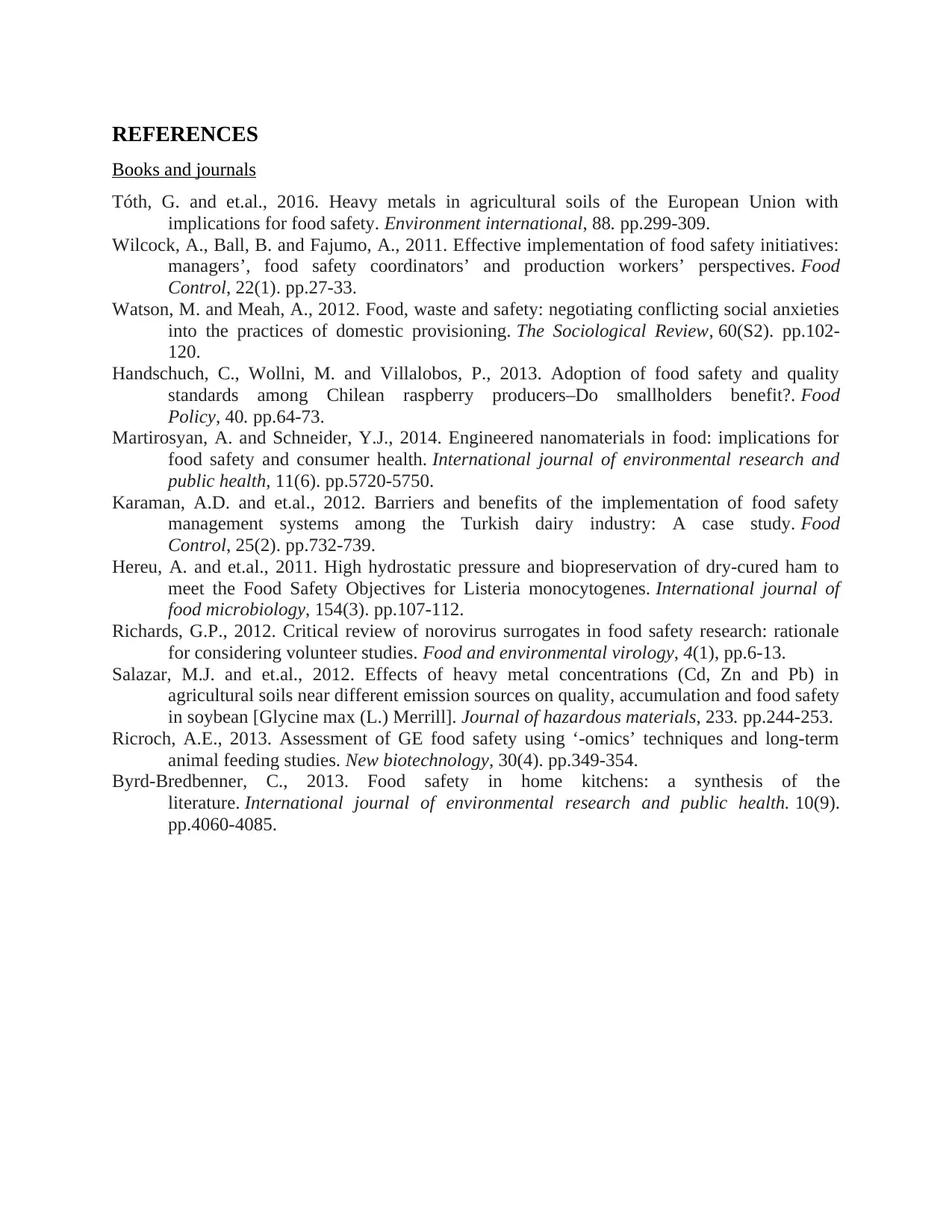
REFERENCES
Books and journals
Tóth, G. and et.al., 2016. Heavy metals in agricultural soils of the European Union with
implications for food safety. Environment international, 88. pp.299-309.
Wilcock, A., Ball, B. and Fajumo, A., 2011. Effective implementation of food safety initiatives:
managers’, food safety coordinators’ and production workers’ perspectives. Food
Control, 22(1). pp.27-33.
Watson, M. and Meah, A., 2012. Food, waste and safety: negotiating conflicting social anxieties
into the practices of domestic provisioning. The Sociological Review, 60(S2). pp.102-
120.
Handschuch, C., Wollni, M. and Villalobos, P., 2013. Adoption of food safety and quality
standards among Chilean raspberry producers–Do smallholders benefit?. Food
Policy, 40. pp.64-73.
Martirosyan, A. and Schneider, Y.J., 2014. Engineered nanomaterials in food: implications for
food safety and consumer health. International journal of environmental research and
public health, 11(6). pp.5720-5750.
Karaman, A.D. and et.al., 2012. Barriers and benefits of the implementation of food safety
management systems among the Turkish dairy industry: A case study. Food
Control, 25(2). pp.732-739.
Hereu, A. and et.al., 2011. High hydrostatic pressure and biopreservation of dry-cured ham to
meet the Food Safety Objectives for Listeria monocytogenes. International journal of
food microbiology, 154(3). pp.107-112.
Richards, G.P., 2012. Critical review of norovirus surrogates in food safety research: rationale
for considering volunteer studies. Food and environmental virology, 4(1), pp.6-13.
Salazar, M.J. and et.al., 2012. Effects of heavy metal concentrations (Cd, Zn and Pb) in
agricultural soils near different emission sources on quality, accumulation and food safety
in soybean [Glycine max (L.) Merrill]. Journal of hazardous materials, 233. pp.244-253.
Ricroch, A.E., 2013. Assessment of GE food safety using ‘-omics’ techniques and long-term
animal feeding studies. New biotechnology, 30(4). pp.349-354.
Byrd-Bredbenner, C., 2013. Food safety in home kitchens: a synthesis of the
literature. International journal of environmental research and public health. 10(9).
pp.4060-4085.
Books and journals
Tóth, G. and et.al., 2016. Heavy metals in agricultural soils of the European Union with
implications for food safety. Environment international, 88. pp.299-309.
Wilcock, A., Ball, B. and Fajumo, A., 2011. Effective implementation of food safety initiatives:
managers’, food safety coordinators’ and production workers’ perspectives. Food
Control, 22(1). pp.27-33.
Watson, M. and Meah, A., 2012. Food, waste and safety: negotiating conflicting social anxieties
into the practices of domestic provisioning. The Sociological Review, 60(S2). pp.102-
120.
Handschuch, C., Wollni, M. and Villalobos, P., 2013. Adoption of food safety and quality
standards among Chilean raspberry producers–Do smallholders benefit?. Food
Policy, 40. pp.64-73.
Martirosyan, A. and Schneider, Y.J., 2014. Engineered nanomaterials in food: implications for
food safety and consumer health. International journal of environmental research and
public health, 11(6). pp.5720-5750.
Karaman, A.D. and et.al., 2012. Barriers and benefits of the implementation of food safety
management systems among the Turkish dairy industry: A case study. Food
Control, 25(2). pp.732-739.
Hereu, A. and et.al., 2011. High hydrostatic pressure and biopreservation of dry-cured ham to
meet the Food Safety Objectives for Listeria monocytogenes. International journal of
food microbiology, 154(3). pp.107-112.
Richards, G.P., 2012. Critical review of norovirus surrogates in food safety research: rationale
for considering volunteer studies. Food and environmental virology, 4(1), pp.6-13.
Salazar, M.J. and et.al., 2012. Effects of heavy metal concentrations (Cd, Zn and Pb) in
agricultural soils near different emission sources on quality, accumulation and food safety
in soybean [Glycine max (L.) Merrill]. Journal of hazardous materials, 233. pp.244-253.
Ricroch, A.E., 2013. Assessment of GE food safety using ‘-omics’ techniques and long-term
animal feeding studies. New biotechnology, 30(4). pp.349-354.
Byrd-Bredbenner, C., 2013. Food safety in home kitchens: a synthesis of the
literature. International journal of environmental research and public health. 10(9).
pp.4060-4085.
1 out of 10
Related Documents
Your All-in-One AI-Powered Toolkit for Academic Success.
+13062052269
info@desklib.com
Available 24*7 on WhatsApp / Email
![[object Object]](/_next/static/media/star-bottom.7253800d.svg)
Unlock your academic potential
© 2024 | Zucol Services PVT LTD | All rights reserved.





